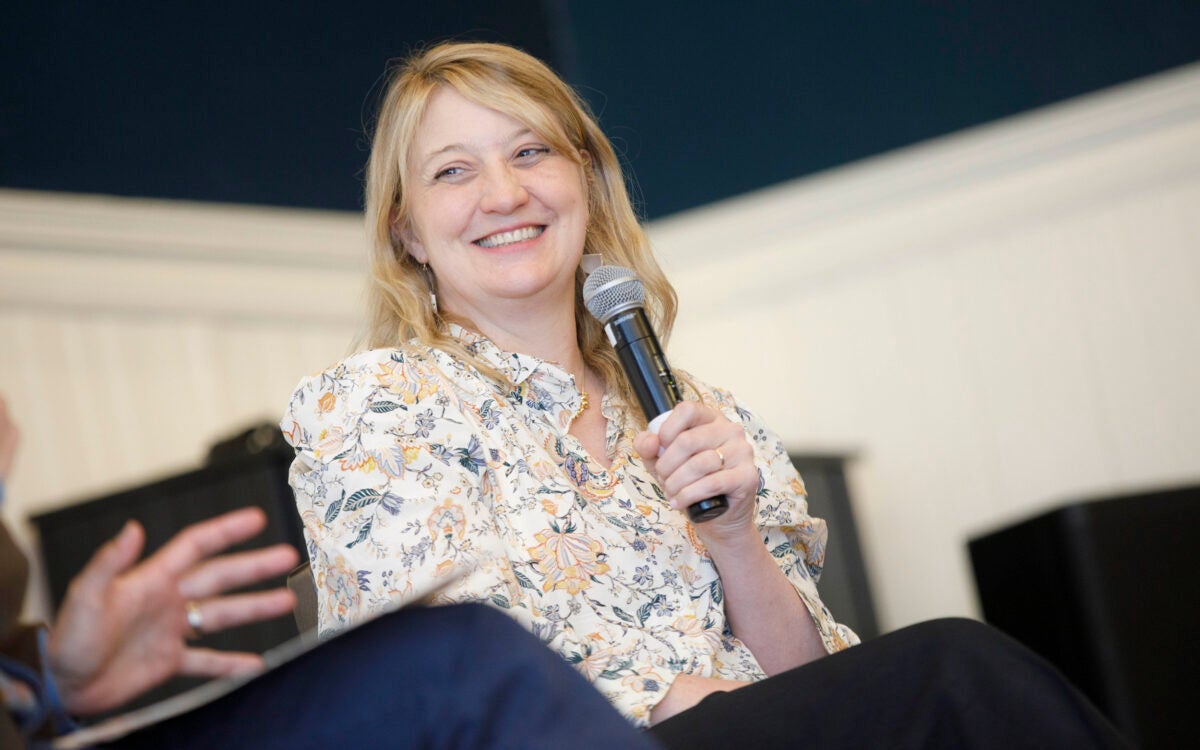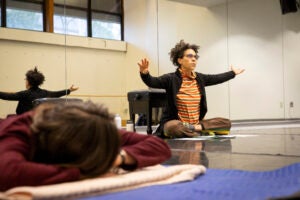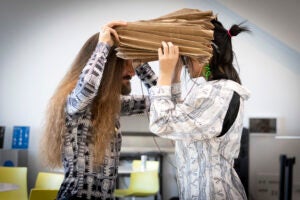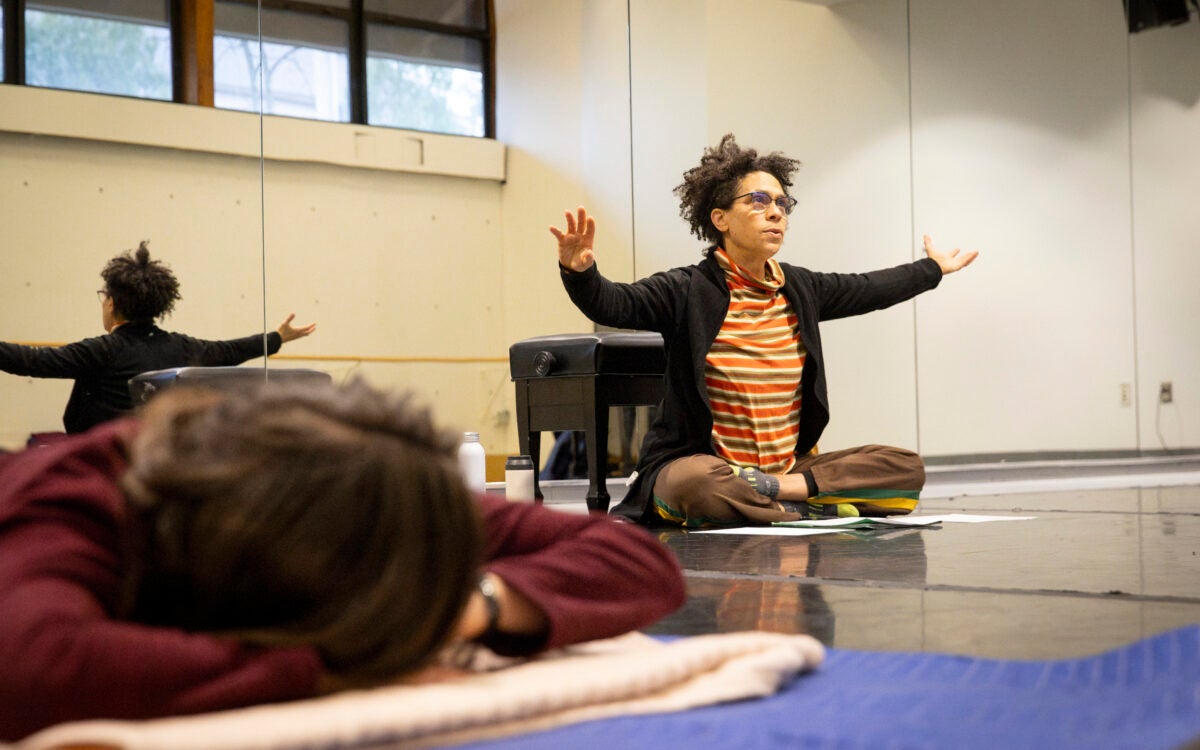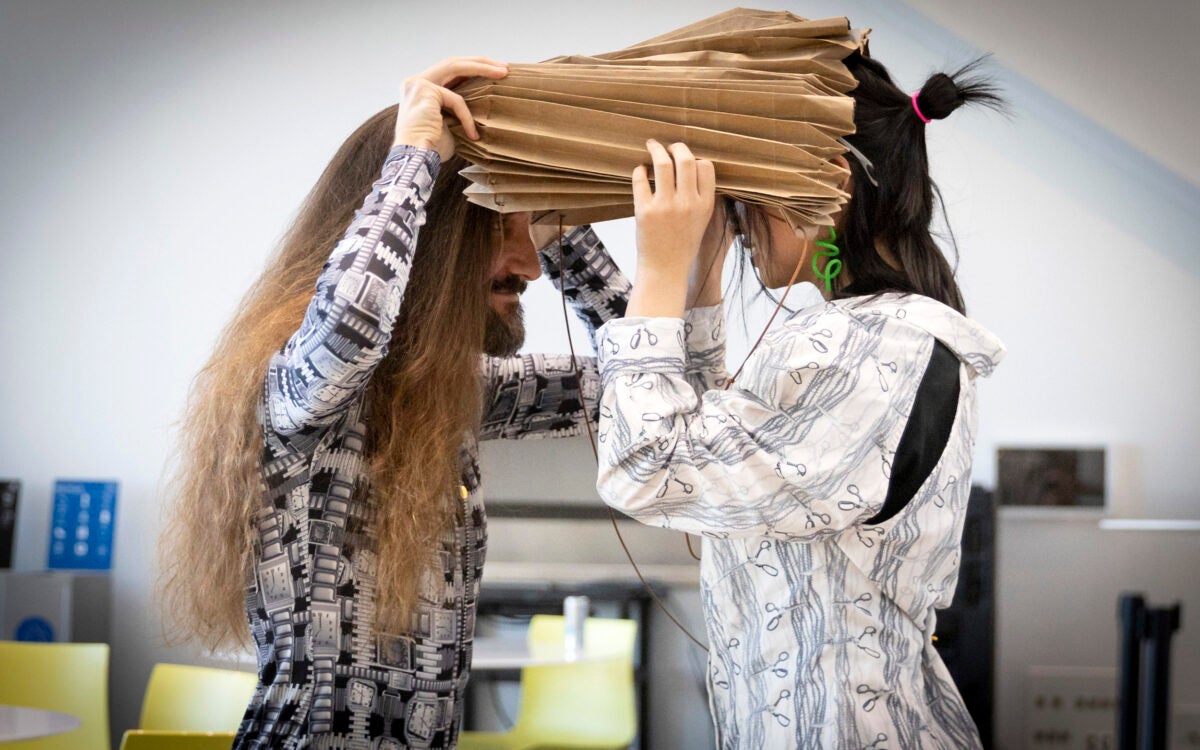A generous vision for Harvard Art Museums
New director Martha Tedeschi talks about her background and goals
In July, Martha Tedeschi became the new Elizabeth and John Moors Cabot Director of the Harvard Art Museums. Prior to arriving at Harvard, Tedeschi was the deputy director for art and research at the Art Institute of Chicago, where she began her career as an Art National Endowment for the Arts intern in 1982 and became a full curator in 1999. A specialist in British and American art, Tedeschi recently spoke with the Gazette about her work in the museum world and her new role at Harvard.
GAZETTE: How did you get interested in art, and why did you decide to make it your life’s work?
TEDESCHI: My father is a historian. He completed both his bachelor’s degree and his Ph.D. at Harvard, and whenever he would have a sabbatical we would live in Europe — Italy mostly. So at a pretty young age I was exposed to beautiful churches, great museums, and the excitement of experiencing other cultures and languages. My mother is a watercolor painter and a book conservator, so we always had the arts and paper in our lives — books and paper. My father was also the head of the special collections department at the Newberry Library in Chicago, which is a great private research library. So research, rare books, and works of art on paper were part of my upbringing. I thought I wanted to be an artist so I did a lot of studio work in high school, especially printmaking. I became very enamored of printmaking so in the end I became a curator of prints and drawings. The apple didn’t really fall that far from the tree. I was attracted to research and writing and scholarship and collections very early, largely through my parents.
GAZETTE: Do you have a favorite artist?
TEDESCHI: The artist I have worked on most is James McNeill Whistler. I’ve also spent a lot of time on Winslow Homer. I am a great fan of both artists. I could say they are my favorite artists because after years and years of studying their lives, reading their letters, and scrutinizing their works of art, I feel that I understand what they were trying to do and that brings a new kind of appreciation.
GAZETTE: Do you still practice any art yourself?
TEDESCHI: Only with my 2-year-old grandson. We were doing vegetable prints recently. We are taking up printmaking.
GAZETTE: You had many different roles at the Art Institute of Chicago. What important lessons did you learn from your time there?
TEDESCHI: I started as an intern and worked my way up — assistant curator, full curator, deputy director. One of the values of having done this is that I have experienced the museum from multiple different vantage points, including most recently from the perspective of senior leadership. And I’ve learned that working in a museum means you need both passion and resilience. We do wonderful, inspiring work in museums. People who work in museums tend to be highly motivated and highly committed. But it’s hard work. Often you are dealing with under-resourced programs, and having to make a case for your projects to the public, to establish relevance. I learned the importance of tenacity and the fact that not everything is going to happen overnight, that we need a certain amount of patience and we need always, I think, to come from a place of generosity. Maybe that is my biggest takeaway. Museums exist in large part to be generous to their communities, to their many audiences. We need always to be thinking about: Are we doing that? And that speaks to the diversity question as well, we want to make sure that we are as welcoming and as inclusive as we possibly can be. That’s one of the ways that we assess what we do. Are we welcoming? Are we inclusive? Are we being generous?
GAZETTE: What about the Harvard job appealed to you?
TEDESCHI: I grew up in an institution that was committed to excellence. The Art Institute of Chicago is a research institution with many similarities to the Harvard Art Museums. These include a real strength in conservation and conservation science and world-class collections. I could not have left the Art Institute without feeling certain that I could continue to be a strong advocate for excellence at my new institution. The Harvard job offers precisely this opportunity. I knew I could transfer my dedication to excellence in museum programming, energized by a fresh new place with enormous potential.
It’s obviously an auspicious moment for this institution because of the new building and the focus on the arts on campus. The Art Museums are a big part of that conversation, and the broad teaching mission is tremendously exciting to me. This aspect is much expanded over my brief at Chicago. I was certainly stewarding some very promising academic initiatives there, but to embrace Harvard’s student-first mandate was very exciting to me. It had become the favorite part of my job in Chicago, and so the possibility of devoting much more of my thinking and my energy to what it means to train and prepare the next generation was really the clincher.
GAZETTE: How do you define your mandate here?
TEDESCHI: A lot of good work is already happening here. I was impressed with what I found when I got here. It’s been almost two years since the building opened, and I think the completion of the first full academic year allows us to see how the programs have developed and seeded across the University. I am happy to see how great that outreach is already, how broadly the museums are partnering with faculty and students across the curriculum. Part of my mandate as director is to make sure that we continue to extend that reach. We want to connect even more with the sciences and the STEM fields, for example. The obvious first-comers to us were probably more in the humanities, which is great. We certainly have the broad, deep collections and excellent facilities to help faculty in the humanities teach in innovative ways. Now I’d like to think in new ways about how to connect more broadly across the University, including to the professional schools. How do we get the business community interested? How do we get emerging professionals benefitting from the fact that there is a great art museum, three great art museums for that matter, in one inspiring building, on their campus? I am giving a lot of thought to that. A major part of my role is as an ambassador for the Art Museums. With my colleagues, I will be reaching out to form new alliances and partnerships at Harvard and in our community, alliances that can extend the impact of the collections, the building, and our programming.
There’s a philanthropy side of this work as well. We need to bring back our supporters and friends who have not been as immersed in what’s happening in the last year, partly because we didn’t have a director, and we need to expand our philanthropic circles to make sure that we are engaging the next generation of supporters, enthusiasts, and collectors. So that’s another big part of any museum director’s work, to keep the institution sustainable.
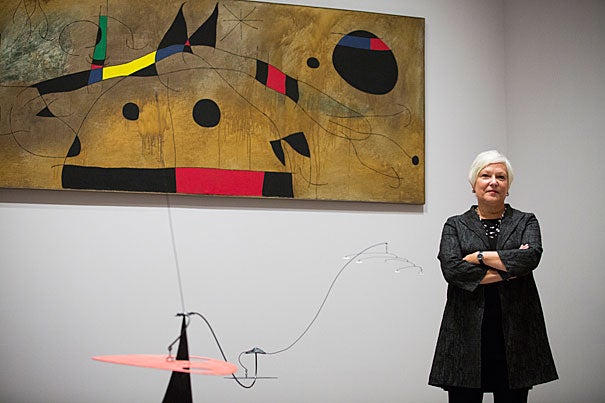
The institution was founded as a laboratory for innovation and so we are taking a hard look at what that means now. We have this wonderful facility on the top floor of the building, the Lightbox Gallery, which has already been the site for some really brilliant partnerships with colleagues on campus. We are interested in pushing innovation that involves technology and digital access to the collections. Our online and digital presence is incredibly important. It’s how we reach our global community, and because we do have global collections that’s very important.
I am also very interested in exploring what we can do with digital publishing, how can we use a nimble form of publishing to make sure that the innovative small exhibitions that are happening in our teaching galleries can have a lasting presence and reach much larger audiences, including other university museums. To go along with that, an aspiration I have is to begin to send a series of exhibitions on tour to other academic art museums that may not have the same collection strengths we do, so that we can encourage the practice of generosity, reciprocity, and collaboration in the field.
GAZETTE: You mentioned reaching out to those in the STEM fields and to business professionals. Why do you feel it is so important to bring people studying or working in those areas into the museums?
TEDESCHI: At the very basic level, art can enrich any life, giving people the occasion to slow down, stop, and look. Experiencing the expression of an intense human emotion or event that might have happened hundreds of years ago connects you to your past. It also connects us to other cultures, which is more important than ever. Certainly that’s important in the STEM and business fields, where so much of what’s happening is happening on a global scale.
We’ve also got these great spaces where art and people can come together in different ways. That includes the most beautiful conservation labs I’ve ever seen. The Straus Center was also the very first conservation science center to be founded in this country, so that’s a great place to involve students in the sciences — material sciences, engineering, chemistry, organic, and inorganic sciences.
And finally, there’s a lot of creativity in most of those disciplines, but I am not sure that students always recognize that they are creative. I like to use the analogy of a scientist who sets up an experiment. Many experiments are iterative; you do them again and again and you improve and tweak the experiment as you learn and assess results. There’s a kind of tenacity that’s required; there’s creativity in figuring out how to tweak, or bring in different materials, or change the experiment to make it accomplish what it is supposed to. There’s a parallel to what many artists do when they create a work of art. Very often the process is iterative — if it doesn’t work the first time, you try it again, you make studies, you do drawings, you edit, you throw it out and start again. The Harvard Art Museums can help the campus see the commonalities that we have here. We are a community of scholars who are carrying out research and research happens for artists, and it happens for scientists as well as broadly across the curriculum. So I think there are ways that we can help students celebrate the creativity in their own fields by drawing analogies to the artistic process.
GAZETTE: What are the greatest strengths of the Harvard Art Museums?
TEDESCHI: One of the greatest strengths is the collection, which now happily is the combination of three unique museums, each with great individual strengths. And although we can’t quite claim to be encyclopedic, we are global and cover a wide diversity of media and subject matter and periods. So from that standpoint it’s an incredible teaching place. Having an excellent staff that can mobilize that collection is incredibly important. I have wonderful colleagues and have been incredibly impressed in the short weeks I have been here with the conversations that we have been having. A third real strength is that we are at Harvard, where we have the most extraordinary opportunities for collaboration across campus. There are conversations and collaborations that you couldn’t have anywhere else, when you bring our collections and our staff and our colleagues on campus together. And that includes of course the students — incredibly smart, motivated, highly engaged students. Bringing students into these collaborations takes it to another level. Those three strengths, I feel, we always will have, and this ensures great things for the institution.
GAZETTE: What are the greatest challenges?
TEDESCHI: We need to get our story out there more. It’s a problem for all museums. How do you put yourself in a central position? How do you establish relevance to your community? How do you get the word out about all the great things that are happening on a daily basis to make sure students and faculty, staff, and community around Harvard are really taking advantage of what we are offering? We have world-class collections and we want our community to know that we are here and that they are welcome. We want members of the Cambridge community to know we are literally at their door. We have a lot of support in the community but I think we could do a lot more. It’s an interesting moment with new directors at many of Boston’s museums. There are opportunities to work together in interesting ways so that Boston as a cultural city becomes stronger as a whole. And we can work together to differentiate ourselves and help the public understand what is unique about each of us.
GAZETTE: Can you tell me about your commitment to diversity and how you hope to further that mission at the Harvard Art Museums?
TEDESCHI: There has been a lot of work, a lot of conversation, around the lack of ethnic and racial diversity in art museums. Art museums are not alone in this, of course, but there are some obvious obstacles that have been working against us in the arts and nonprofit sectors, and the goal of having really diverse representation on our staffs, on our boards in museums, is still just that, a goal. This is a national, even an international, conversation. I am very motivated to see how the Harvard Art Museums and our campus partners can contribute to that and how we can make strides in our own practice here.
There are some ways that are relatively easy. For example, making sure that our menu of special exhibitions is truly wide-ranging and offers a diversity of voices and perspectives, that we are really making the most of our global collections to showcase a multiplicity of cultures, backgrounds, and traditions. More challenging in the museum field is diversity in hiring, but many museums are talking about that now. Here, we are making a concerted effort to make sure that whenever we have an opening we have a truly diverse pool before we begin to select finalists and decide who comes to campus for an interview. We won’t start that process until we have a diverse pool of candidates. That’s a slow process, but it’s really important that we are all thinking and working that way. And I am really interested in getting students from traditionally under-represented backgrounds involved in our training programs here so that we begin to contribute to a more inclusive pipeline into the curatorial field, into museum leadership. I was working on a curatorial training program with these goals in Chicago and I am excited to consider how such an initiative could be launched in a university setting — that’s definitely on my wish list for the future.
